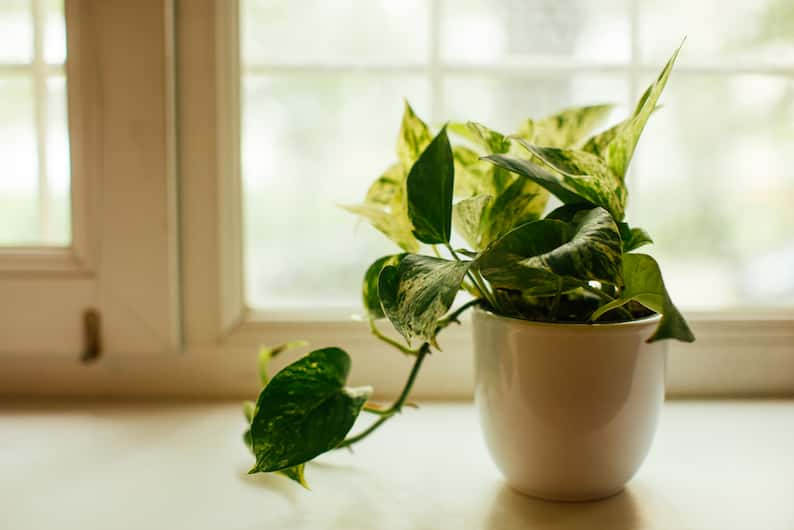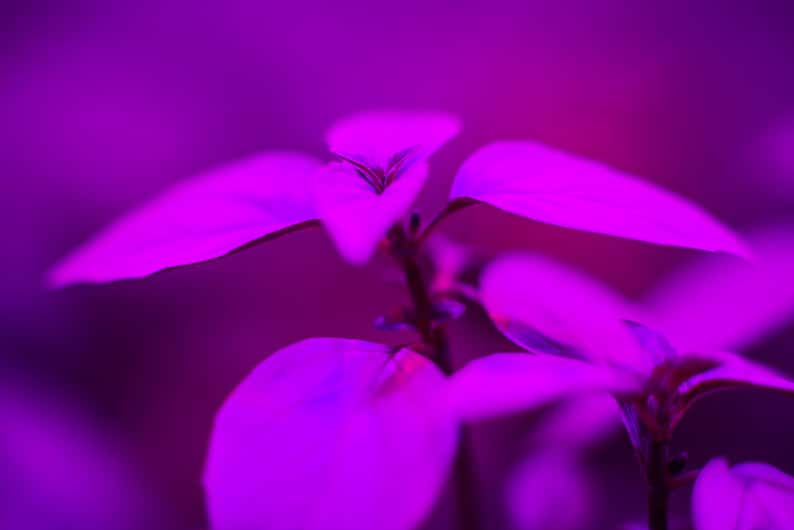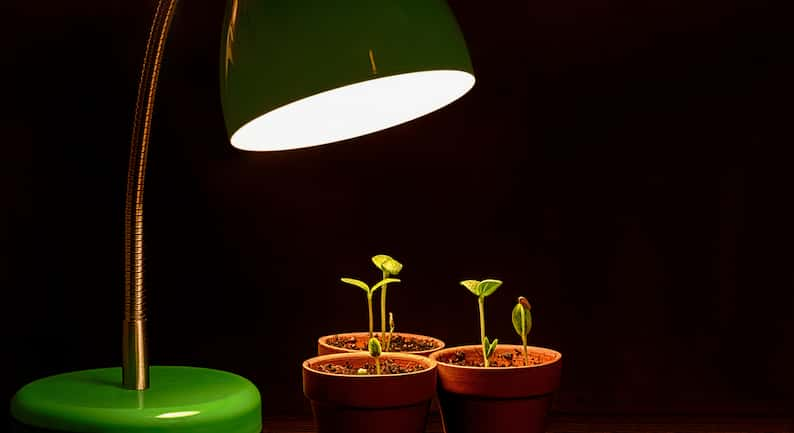Pothos plants are always the first houseplants I recommend to people who want to start collecting houseplants. They grow quickly, have beautiful leaves, and can tolerate a considerable amount of neglect.
However, even though they’re definitely one of the easier plants to look after, they still do have some requirements – and that includes that it’s important to meet your pothos’ light needs.
Don’t worry, they’re not too fussy there either. But you can be in for some problems if you don’t know things like exactly how many hours of sunlight do pothos need or which window they prefer. This means it’s best to avoid those problems in advance and learn all about the light that a pothos should get!

Table of Contents
How much light should a pothos get?
Pothos plants need 12 to 14 hours of bright, indirect light each day. It is okay for them to receive a few hours of direct light, although too much can burn them. Similarly, it is also fine for a pothos to get a few hours of low-light conditions, although their growth may be stunted.
Pothos plants natively grow in the warm climates of Australia, China, India, Indonesia, and Japan. They naturally grow under jungle canopies and on the trunks of tropical trees. For the majority of the day, they receive bright and indirect light, though they may catch direct glimpses of the sun throughout the day.
Keep this climate setting in mind when choosing a place for your new pothos plant as your pothos’ light needs are best met by following its natural habitat. The best location in your home allows your pothos to view the blue skies all day, but not see the sun, or only see the sun for a few hours at a time.
Worried that your pothos has gotten too much sun? Take a look at our guide on how to deal with a pothos with sunburn, including how to save your plant when this happens.
What kind of light does a pothos need?
Pothos need bright, indirect light for the majority of the day. However, they can tolerate low light and some direct sunshine in short durations. While growth won’t be ideal in those conditions, your pothos plant will still survive.
They can tolerate environments ranging from bright direct sunshine, all the way to dark and completely windowless offices with only a few fluorescent light bulbs. Their range of survivability is what makes them one of the best, most popular, and most sought-after house plants on the market.
Can pothos grow in low light?
Pothos can grow in low light and will not die. Still, their growth will be stunted and slowed, because while low light is tolerated, it is not preferred. If you are happy with the size and foliage of your plant, it is likely okay to leave it in a low-light room.
If your pothos has variegated leaves and you leave it in low light most of the time, the variegation will likely fade on existing leaves, and completely disappear on new leaf growth.
Even for non-variegated leaves, growing a pothos in low light can see it become leggy. If you’re looking for how to make your pothos fuller, checking that it’s getting sufficient light is usually a good first step given that this is often the problem in this situation.

Can you put pothos in full sun?
It is not ideal for pothos to be placed in full sun. However, the plant can tolerate full sun for a few hours a day, provided that you slowly acclimate the plant to this light, and it seems to be accepting of the change.
If your pothos plant tolerates full sun well, your pothos can live outside during the warm and sunny months in the summer. This will likely result in an explosion of growth, bright leaves, lots of variegation (if you have a variegated variety of pothos, like the Snow Queen or Marble Queen pothos), and giant leaves.
Just make sure that once the summer draws to a close, you acclimate it back under shade slowly, and before cold weather sets in. You should also inspect and treat your pothos for pests and mites that can hitchhike back inside your home before it returns indoors.
Where is the best place to put pothos?
The best location for a pothos plant is where it receives bright, yet filtered light. For an indoor pothos, this may be behind a sheer curtain or near a window that doesn’t receive too much direct light, to avoid burning your plant.
Usually, a south-oriented room with windows pointing south is a good option for houseplants, pothos included. Just make sure that your plant isn’t getting excessive amounts of light there. For that reason, you may find that your east and west-facing rooms prove to serve pothos plants better or, at the very least, positioning your pothos a few feet away from the south-facing window.

Finally, we have the north-facing rooms. If you have several houseplants, you may want to keep your pothos in your northern exposure rooms just because they can tolerate the lower levels of light better than most other plants. However, if you want your pothos to grow quickly and produce large leaves though, skip the north-facing rooms as they aren’t absolutely ideal for meeting your pothos’ light needs.
I have kept pothos plants in my previous home’s northern kitchen, and I noticed that those plants were significantly leggier, slower growing, and with small, one to two-inch-long leaves. In my current home, my living room has windows on all four walls, plus a giant skylight. Actually, my golden pothos now produces leaves that are six to eight inches long and four or five inches wide. Turns out that positioning and natural light exposure really matter!
Related: How Fast Does Pothos Grow (and How to Make it Grow Faster)?
Do pothos need to be by a window?
Pothos plants do not necessarily have to be placed near a window, but closer proximity will encourage growth. Just make sure that it is not touching the glass or that the light coming through the window isn’t excessive, as the leaves may burn.
You can place your pothos on a table near the window, hang it from a curtain rod with macrame, set it on a hanging window plant shelf, place it directly on the windowsill, or set it anywhere in your home where it will be able to see the blue skies out of the window.
What window is best for pothos?
The best window for a pothos plant is a south-facing window. The second best window orientation is east and west, followed by northern exposure windows. That said, a pothos is fine near basically any window where it gets enough light, just as long as it’s not right next to the window where it can burn.
Some houseplant lovers claim that east and west-facing windows are better locations than south-facing windows, but I have to disagree. As long as you slowly acclimate your plant to the increased exposure to bright, direct sunshine, it will do quite well in a south-facing window.

My pothos plants that live near southern exposure windows grow considerably faster and larger than my pothos that sit in east and west facing windows. I will warn you though, If you don’t take the time to acclimate your pothos to the change, it may lose a few leaves during its adjustment period.
If you don’t want to move your plant around a lot to acclimate, or you don’t want to run the risk of losing leaves, stick to east or west windows. If you’re running out of window space thanks to a healthy houseplant collection, go to a north-facing window instead.
FYI: No matter which window you decide to place your pothos in, you should also keep an eye on how dry your plant gets in its new location. Heat from the window, especially with bright indirect sunshine, can really sap your plant and its soil of essential moisture and humidity.
Water your plant deeply and frequently and, if you can, provide a humidifier too. This will be beneficial for your plants’ growth, as well as your own health, especially during the summer (if you don’t already live in a humid climate).
Can pothos be in a south-facing window?
Pothos can be in a south-facing window; they just need to be acclimated. The best way to acclimate a pothos to a south-facing window is to set it in the direct light for a few extra minutes longer every day. You should also make sure your plant is not right next to the window so it’s not getting direct light.
If your pothos is conditioned to an east or west facing window where it receives two or three hours of direct light a day, then give it four hours in the south-facing window for the first two weeks. Slowly add in an extra hour of direct south-facing sunshine exposure every week after that.
This will prevent your plant from stressing and dropping leaves. After your plant is acclimated, you should notice an acceleration of growth, especially during the summer months.
How do I know if my pothos is getting too much light?
If your pothos plant starts to develop yellow, pale, or even white, you know it has been exposed to too much light. Dark green varieties of pothos plants are more likely to have this issue, and won’t tolerate the extra-brightness as well as other, more variegated species.
If your plant is turning pale, immediately move it to a new location where it can still see the sky, but won’t be directly touched by the sun’s powerful rays.

How do I know if my pothos’ light needs aren’t being met?
If your plant is supposed to be variegated but is losing its white splashes of color, it probably isn’t getting enough sunshine. If your pothos isn’t variegated, you’ll know that the light is insufficient by slow or no growth, small leaves, legginess or weakness, such as droopy leaves.
A pothos that isn’t getting enough light will often act similar to a plant that isn’t getting enough water. If your pothos has been watered recently and still looks limp or weak, it’s probably due to the lack of light.
Find out more: 9 Reasons Why Your Pothos Is Drooping (and How to Fix It)
How to check how much light my pothos is getting
If your houseplant is casting a well-defined shadow, or you can see the sun from your plant’s positioning, it means it is getting direct, bright light. If your pothos doesn’t cast a shadow, or the shadow is very light and ill-defined, and you can see the sky but no sun, it means it is getting bright, indirect light.
One easy test is that if you can’t easily read a book without an additional light source right by your plant, it is getting low light. Pothos plants can likely survive each of these situations. Still, the best situation is a day that is primarily filled with bright, indirect light, and only a couple or a few hours of bright, direct light.
Do pothos like LED lights?
Pothos plants react very well to LED lights. They can be particularly useful if your plants aren’t getting enough natural light, such as due to where they are positioned or during the colder months when days are shorter and there is less light. In those cases, buying an LED grow light can be great for your pothos.
Many grow lights are LED, and even if your LED lights aren’t labeled for plants, your pothos will likely appreciate them and grow a considerable amount underneath them.

Low light plants like the pothos, philodendron, ZZ plants, some ferns, palms, snake plants, and bamboo can often find enough light in a residential LED lamp to survive, even if there are no windows in the room. This is why these plants, especially the pothos, are sought after by professionals who work in cubicles and windowless offices.
While a small lamp or two isn’t ideal, it is enough to sustain life. Still, your plant will not grow large or very quickly in these conditions, so take that into consideration.
If you are serious about encouraging plant growth for your pothos, invest in an LED grow light. I will go into further detail on the different grow lights below.
What color light is best for pothos?
The best color light for pothos is violet-blue in the 400 to the 520-nanometer range. This color and intensity are best for photosynthesis and chlorophyll absorption, which results in speedier growth and larger leaves.
It is common to see red light setups in the homes of other indoor gardeners and for sale in many nurseries. While this color is useful for many applications, it is not helpful for pothos. That’s because red light promotes flowering, which is ideal for flowering plants and vegetables, but not for the pothos.
Did you know: The last pothos plant bloomed in 1962, fifty years ago. The plant developed a genetic mutation that inhibits its ability to produce flowers. Pothos should have died then, but humans have continued to prune and propagate pothos ever since. Almost all pothos plants are clones now.
Based on this, pothos light needs are limited to growth and color, not bloom or your pothos’ seed production.
Can pothos survive in fluorescent light?
Pothos can survive in fluorescent lighting, whether it is a residential fluorescent light bulb or an office tube light. Pothos will keep small leaves and won’t grow the typical twelve to eighteen inches during the summer, but it should stay a beautiful green color with a sleek sheen on its leaves.
The closer your plant sits to the fluorescent light, the better it will grow.
Keep in mind: If you ever move your plant back to a room that has windows, avoid direct sunshine for a few months at least so the plant can acclimate to the new environment.
What’s the best grow light for pothos?
The best grow light for pothos is an LED violet-blue grow light. With that said, pothos is not picky and should do well with most grow lights, so really the best grow light is the one that works the best for you in your space.
If you plan to use grow lights regularly, you should probably water your pothos more often, and deeply. Grow lights are more efficient now than ever, but they still produce some amount of heat, which dries your plant and its soil out. Heat is good for a pothos, although these tropical plants prefer a temperature that ranges from 65 to 85 degrees Fahrenheit.
Adding a humidifier to your space can also be beneficial, as the grow lights can lower humidity levels. Pothos like humidity, with these plants finding 60% to 80% humidity levels most ideal.

Should I use tubes, panels, or bulbs for my grow light?
I have a variety of grow lights, from LED grow tubes, to hanging panels, desk grow lights, and simple light bulbs that can go into any light fixture. While LED grow tube lights are my favorite option, I have to say that the bulbs that can be screwed into residential or decorative light fixtures are the most practical.
It is so easy to buy a pack of grow light bulbs online and put them in your existing lamps because they keep you from having to buy more lamps. In addition, they don’t take up much space at all, they’re cost-effective, and they’re much prettier than traditional grow light setups – all while meeting your pothos’ light needs!
Should I keep my pothos’ grow light on all day for maximum growth?
Your grow light should be turned off for at least 33% of the day. This isn’t because of limitations of the grow light but, rather, your plant needs darkness to move nutrients around, store energy in the appropriate places, restore any damages sustained, and actually grow.
One of the most distinctive mistakes I remember making as a new gardener (houseplant and vegetable) was thinking that more light meant a healthier plant. I actually stunted my plants’ growth by doing this and wasted quite a bit of energy and electricity in the process.
I also strongly recommend a timer for your grow lights. Even if you do a great job of remembering to turn your lights on and off, it’s just one more thing to remember, and most of us get into houseplants and gardening to quiet our minds. If you’re able, do yourself the favor of treating yourself to timers.
If you keep irregular hours or work the night shift, it is okay to rearrange your grow light ‘on’ hours. Your plants don’t need to get their light during the daylight. If you need all the lights off for optimal sleep, make your lights run while you’re awake or at work. J
ust make sure that you close your blinds or limit the light on your plants for at least eight hours a day. Like people, most plants need eight hours to fully rest and recharge.
